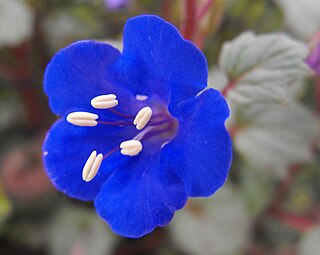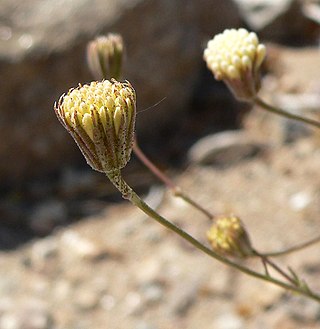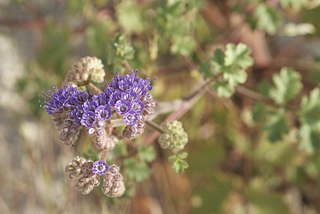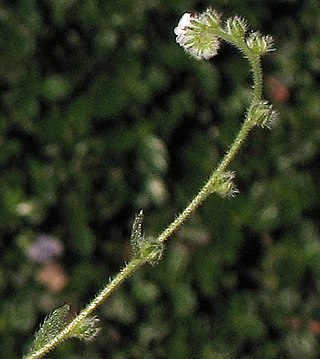
Phacelia fremontii is a flowering plant in the family Boraginaceae native to the southwestern United States. In California, its range includes the Mojave Desert, the San Joaquin Valley, the Coast Ranges, and the Sierra Nevada. It was named for John C. Frémont.

Phacelia minor, with the common names Whitlavia and wild Canterbury bells, is a species of phacelia. It is native to Southern California and Baja California, where it grows in the Colorado Desert and the coastal and inland mountains of the Transverse-Peninsular Ranges, often in chaparral and areas recently burned.

Phacelia campanularia is a species of flowering plant in the borage family, Boraginaceae, known by the common names desertbells, desert bluebells, California-bluebell, desert scorpionweed, and desert Canterbury bells. Its true native range is within the borders of California, in the Mojave and Sonoran Deserts, but it is commonly cultivated as an ornamental plant and it can be found growing elsewhere as an introduced species.

Primula pauciflora, the pretty shooting star, few-flowered shooting star, dark throat shooting star or prairie shooting star, is a species of flowering plant in the primula family Primulaceae. It is a widespread and very variable species, native to western North America, from Subarctic America to Mexico, often in xeric and desert habitats. It is found in the Great Basin Deserts and Mojave Desert. Its synonyms include Dodecatheon pauciflorum and Dodecatheon pulchellum.

Chaenactis carphoclinia is a species of flowering plant in the daisy family known by the common name pebble pincushion. It is native to the southwestern United States and northwestern Mexico, where it grows in rocky and gravelly habitat, such as the California deserts. The species is found in southern California, Nevada, Utah, Arizona, southwestern New Mexico, Baja California, Sonora.
Linanthus orcuttii is an uncommon species of flowering plant in the phlox family known by the common name Orcutt's linanthus. It is known only from southern California and Baja California, where it grows in chaparral and pine forests in the Peninsular Ranges and occasionally the San Bernardino Mountains.

Penstemon spectabilis is a species of penstemon known by the common name showy penstemon or showy beardtongue. It is native to southern California and Baja California, where it grows in the chaparral, scrub, and woodlands of the coastal mountain ranges.
Phacelia adenophora is a species of phacelia known by the common name glandular yellow phacelia. It is native to the northwestern United States where it can be found in Oregon, northeastern California, and northwestern Nevada. It grows in mountain and plateau habitat. This is an annual herb producing decumbent, creeping, spreading, or upright branched stems up to 40 centimeters long. The leaves are oblong in shape and deeply lobed, measuring up to 3 centimeters long, and concentrated at the base. The inflorescence is a one-sided cyme of many bell-shaped flowers each under 1 cm long. The petals are fused at the base with five lobes. Unlike many phacelias, which bloom in shades of blue and purple, this species has yellow to golden flowers. It occasionally has purple edges on the corolla. It has five hairy stamens. The fruit is a fuzzy, oblong capsule a few millimeters in length containing up to 14 seeds.
Phacelia affinis is a species of flowering plant in the borage family, Boraginaceae, known by the common names limestone phacelia and purple-bell scorpionweed. It is native to the southwestern United States and Baja California and Sonora in Mexico. It can be found in scrub, woodland, forest, and other habitat.

Phacelia brachyloba is a species of phacelia known by the common name shortlobe phacelia. It is native to southern California and Baja California, where it grows in the coastal mountains, canyons, and valleys. It is one of the many species known as fire followers, that emerge in areas recently burned.

Phacelia ciliata is a species of phacelia known by the common name Great Valley phacelia. It is native to California, where it can be found in many of the coastal mountain ranges, the Central Valley, and the Sierra Nevada foothills; its distribution extends into Baja California. It grows in grasslands and low mountain slopes.

Phacelia curvipes is a species of flowering plant in the borage family, Boraginaceae, known by the common names Washoe phacelia and Washoe scorpionweed. It is native to the southwestern United States, where it grows in many types of habitat, such as chaparral, oak and pine woodland, and forests.

Phacelia davidsonii is a species of phacelia known by the English name Davidson's phacelia named by Asa Gray for the discoverer of this annual plant, Anstruther Davidson, a Scottish naturalist who emigrated from Scotland to Los Angeles, California, in the late nineteenth century. This native forb occurs in southern California and southern Nevada, where it grows in mountains and foothills in chaparral and woodland habitats. In California, this herb is found in the Southern Sierra Nevada, Transverse Ranges, and Peninsular Ranges.

Phacelia grandiflora is a species of phacelia known by the common name largeflower phacelia. It is native to the coastal hills and southern Transverse Ranges of southern California and Baja California, where it grows in coastal sage scrub, chaparral, and other local habitat, including areas recently burned by wildfire.

Phacelia hastata is a species of flowering plant in the borage family, Boraginaceae. Its common names include silverleaf scorpionweed, silverleaf phacelia, and white-leaf phacelia. It is native to western North America from British Columbia and Alberta south to California and east to Nebraska. It can be found in many types of habitat, including scrub, woodland, and forest, up to an elevation of 13,000 feet. It prefers sandy to rocky soil.

Phacelia parryi is a species of phacelia known by the common name Parry's phacelia.

Phacelia pedicellata is a species of flowering plant in the borage family, Boraginaceae. Its common names include specter phacelia and pedicellate phacelia. It is native to the southwestern United States and Baja California, where it can be found in several types of habitat, including creosote bush scrub and Joshua tree woodland.

Microsteris is a monotypic genus of flowering plants in the phlox family containing the single species Microsteris gracilis, known by the common name slender phlox.

Plagiobothrys collinus is a species of flowering plant in the borage family known by the common name Cooper's popcornflower.

Saltugilia is a genus of flowering plants in the phlox family, Polemoniaceae. They are known commonly as woodland gilias. There are four species. Two are endemic to California in the United States, and the distributions of the other two extend into Baja California in Mexico.



















